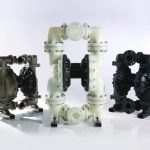Se você já possui uma bomba pneumática de diafragma ou está planejando adquirir uma, já sabe o quanto esse equipamento é versátil. Trazendo confiabilidade; segurança, flexibilidade e versatilidade, essas bombas são valiosas aliadas de quem busca um equipamento confiável para a sua empresa.
Contudo, mesmo que seja extremamente funcional, sempre é possível otimizar o seu desempenho, independentemente da sua aplicação. Veja a seguir, algumas dicas que preparamos para te ajudar nessa missão. Confira!
Use properly sized connections
It is very important to make sure that the connections used on the pump inlet and outlet are the correct size. This means that if you are using a two-inch pump, the piping must be the same ratio. When the connections are smaller, the flow of the pump can be affected, as well as the longevity of its diaphragm.
Ensure a clean air supply
Air quality plays a key role in the performance of your pneumatic diaphragm pump. When the compressed air used is not pure enough, or is too humid, both the operation and the durability of the pump can be impaired. Contaminants can damage seals and diaphragms. To avoid this type of problem, you can use an air filter or regulator, in addition to maintaining periodic maintenance of the compressed air system.
Keep an eye on your bomb
We know that every plant is completely unique, as are the applications, making it difficult to identify signs that indicate an impending pneumatic diaphragm pump failure. In order to be able to calculate the durability of your pump, it is important to research its operation in similar applications and monitor its performance over time, keeping maintenance stops up to date.
Use accessories
Some accessories can help you improve the performance of your pneumatic diaphragm pump, such as:
Flexible Fluid Connections: By reducing fluid pulsation, this component can help you reduce strain, preventing leaks and damage.
pressure gauges: they help in effective pump control and solve system problems (blockages, restrictions or pressure fluctuations);
Inlet stabilizers: installed on the suction side of the pump, they can reduce inlet pressure peaks or surges;
check the hardware
Whenever a new pump is installed (or reinstalled after a repair), it is important to check all pump tightness. Due to material creep, temperature changes and vibration, components can eventually come loose. For this, it is important to know:
When tightening, the pump must not be under pressure;
If the pump is not tightened properly, the seals can be damaged.
Have a maintenance protocol
Maintaining a schedule of maintenance shutdowns helps improve the performance and extend the life of your pump. In addition, when any repairs are carried out, it is important to replace all components. In this way you can reduce the costs required for disassembly and downtime of the pneumatic diaphragm pump.










